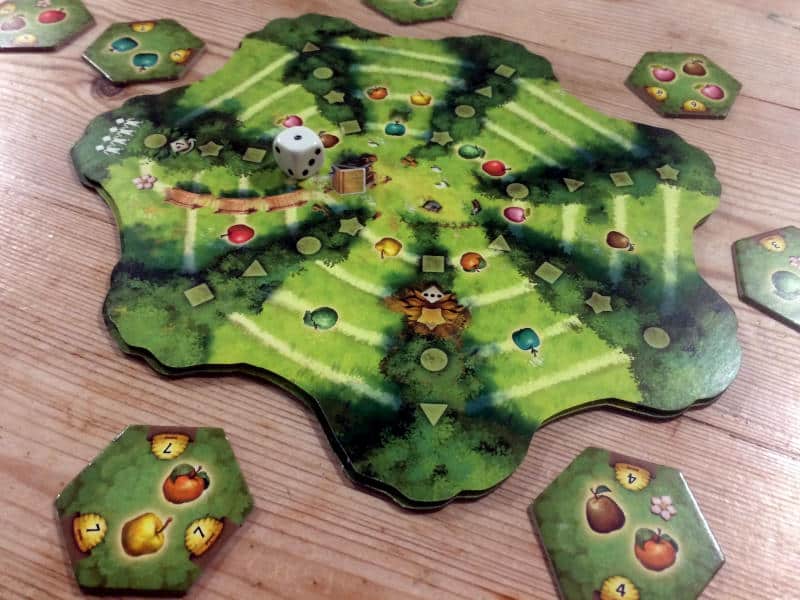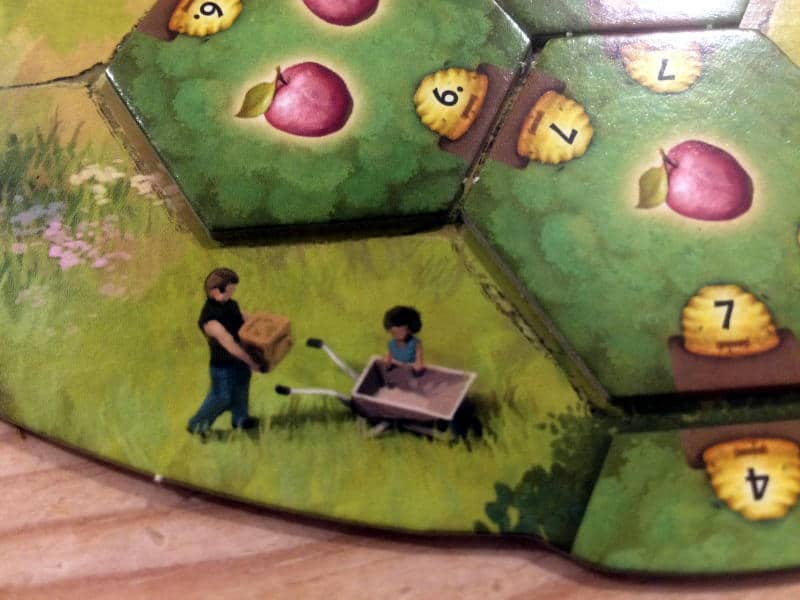| Release Date: 2022 | Players: 1-4 |
| Designer: Uwe Rosenberg | Length: 45-75 minutes |
| Artist: Lukas Siegmon | Age: 8+ |
| Publisher: The Game Builders | Complexity: 1.5 / 5 |
| Plastic (by weight): <1% | Air (by volume): 45% |
To create the best apple brandy, you have to freeze fermented cider and remove the ice. It’s quite simple and very effective in increasing the alcohol content of an already delicious drink. It’s really easy to apply this to cider made after the autumn harvest. Just leave the casks in the winter cold and when enough ice has formed, pour the remaining liquid into another cask. Repeat the process as often as you please to concentrate the remaining liquid to levels of anywhere between 25% and 40% alcohol. It’s what we call “jacking” and it will come as no surprise that the resulting drink is called Applejack by Uwe Rosenberg from The Game Builders.
Apples and Pears
Of course, there is a historical background that this hex-tile-laying game is set against, but only very loosely. So while the rulebook describes the history of the highly alcoholic drink applejack, it also admits that the game’s namesake is actually “a non-alcoholic taster of apples”. It’s still a catchy title for a game that is set in an apple orchard full of different varieties of apple trees, a number of bee hives and plenty of flowers to keep the vital pollinators happy.
What you’re really doing in the game though is placing hexagonal tiles onto your player board that you draft from a sort of carousel of tiles. It’s actually more of a spiral and it’s not the tiles that rotate, but instead, a dice makes its way from the edge of the market board towards its centre on a helical path. It might sound confusing, but in reality, it’s really straightforward. It’s all there in front of you, printed on the central board. Once you know what the symbols mean, you can play the game without having to refer to the rulebook ever again.
The thing is, the graphic design and illustrations are maybe a tiny bit too subtle and the rulebook doesn’t necessarily point it all out to you either. There are so many clues there to help you play the game, but it’s not immediately obvious that they are there. Once you have worked it out though, the game really flows, showing how clever the choice of symbology really is.

Planting Trees
The gameplay is pretty simple. On your turn, you take one of the tiles on either side of the dice’s current location. That’s up to four at the beginning of the game, but more likely only two or three later on. That’s quite neat and means that you have more choice when you start and when your orchard is still empty. Once you have chosen and paid for your hex, you place it anywhere on your player board. Well, that is, on any of the preprinted hex locations of course and not on top of an already placed tile. Otherwise though, you have free reign. You don’t have to place tiles next to each other or anything. The orchard is your oyster, so to speak.
Mind you, there are certain things you do want to consider. Tiles have bee hives printed on them, which show the cost of the tile. Lining these up with other bee hives already in your orchard gives you some money back. I say money, but it’s actually honey. Honey is liquid gold after all. So that’s your first consideration.
Next, you want to try and create large, continuous sections of the same apple variety. So placing like apples next to each is your goal. Some tiles will have only a single variety on them, while others have two, three or more. That means you can have different varieties overlap each other, making the creation of larger areas a little easier. However, if you’re not careful, you can still paint yourself into a corner, so to speak.
Harvest Time
After you’re done, the dice moves one step along the spiral and it’s the next player’s turn. In some places, apples are printed on the path. These indicate which apple variety scores at that point. Also, each step is marked with a different geometric shape and there are two double-sided market boards, which you select based on player count. That way, every player has a specific shape assigned to them.
It’s what I mentioned earlier about the graphic design. Using the geometric shapes, you can look ahead to see what tiles are likely going to be available when the round comes back to you. Keeping an eye on when the various apple varieties score also really helps you to plan ahead, at least to some degree.
Chances are, that the first few scoring opportunities don’t give you much honey, which is points, as well as money in Applejack. Your orchard is still new, but it won’t take long until you have larger areas that will give you more honey. Even so, you’re still going to miss out on points for some varieties which you haven’t been able to develop yet. If you do it right though, you will have a well-balanced orchard with every possible variety present in large numbers.
That’s the trick though. It’s not necessarily about scoring a lot of points straight away. Investing in a wide variety of apples and ensuring they connect up to form large areas is almost more important. After all, at the end of the game, you get additional and possibly a large number of points for having more varieties present in your orchard with a minimum size.

Multiple Ways to Victory
There are other ways to get points as well. Cleverly placing your bee hives can make a good amount of honey points. Flowers also score a good chunk of points, especially if you add them to your orchard early. Having many ways to victory is great, but at the same time, is what makes Applejack such a wonderfully challenging puzzle. Not only are you trying to find the perfect tile, but you also need to find the perfect spot for it. It’s absolutely delicious when you can find the perfect solution. It really tickles your brain cells and makes them fire at full pelt, without making the game too overwhelming a challenge.
Something else to bear in mind is that Applejack is mostly a multiplayer solitaire game. The only way to interfere with other players is to choose a tile that the next player desperately wants. However, it takes enough focus to work out what’s right for your orchard that you’re unlikely to know what the person on your left is looking for. You’re all really just puzzling out your own puzzle.
Overall, Applejack is a wonderful game. The components are really good quality, with the cardboard thickness ensuring the game will last a long time and the illustrations are really lovely and fitting. Personally, I don’t like the cardboard honey money point tokens and would prefer poker chips, but maybe that’s really only my personal preference. I just think the single-point tokens are too small and too fiddly.
Other than that, the rulebook is well-written and the game is easy to pick up. As I said, once you understand the symbology, you can play the game without referencing the rulebook. There is even a scorepad to help with end-game scoring. It really is all there.
It’s the Buzz
Applejack is going to stay in my collection for some time to come. It’s an evergreen title for me and will come out regularly. It really scratches a lot of itches for me and will appeal to anyone who likes the visual puzzle it creates and that is different every time you play it. I really can’t recommend it highly enough, especially with a bottle of apple juice by your side.
Useful Links
- Applejack: https://gamebuilders.
de/ spiele/ applejack/ - Rulebook: https://gamebuilders.
de/ wp-content/ uploads/ 2022/ 09/ Applejack_ rules_ english. pdf - The Game Builders: https://gamebuilders.
de/ - BGG listing: https://boardgamegeek.
com/ boardgame/ 367662/ applejack
Transparency Facts
I feel that this review reflects my own, independent and honest opinion, but the facts below allow you to decide whether you think that I was influenced in any way.- I bought and paid for the game myself.
- At the time of writing, neither the designers, nor the publisher, nor anyone linked to the game supported me financially or by payment in kind.
Audio Version
Intro Music: Bomber (Sting) by Riot (https://www.
Sound Effects: bbc.co.uk – © copyright 2023 BBC
Main Music: You Are My Rainbow by Unicorn (https://www.
Playlist
These are the songs I listened to while I was writing this review:

